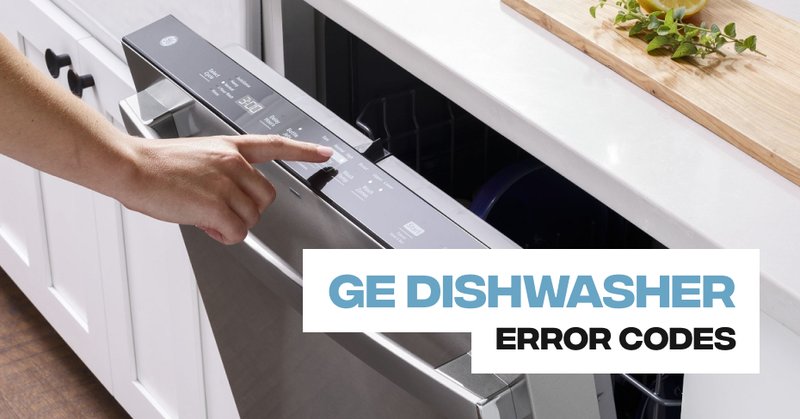
Here’s the deal: the E1 error code on GE dishwashers usually indicates a problem with water intake. Imagine you’re filling a bathtub, but the water flow is slow or inconsistent due to a kinked hose. Similarly, when your dishwasher gets an E1 code, it’s like it’s telling you, “Hey, I’m not getting enough water to do my job properly!” This code is your dishwasher’s way of alerting you to a potential issue with how water is entering the appliance, which can definitely affect its cleaning performance.
You might be wondering if using your dishwasher while it’s giving you the E1 error is safe. Well, using any appliance that signals a problem isn’t ideal. It might still run, but that doesn’t mean everything is okay. In this case, it’s more about ensuring the appliance isn’t damaging itself or your dishes due to improper function, which leads us to explore what actions you might want to consider.
Understanding the E1 Error Code
So, what’s really happening when the E1 error code appears? This error is commonly associated with water intake issues. Think about the importance of water in a dishwasher — it’s like flour in a cake. Without the right amount, things just won’t work as they should. The E1 code generally means that the dishwasher isn’t receiving enough water, or it’s taking too long to fill to the proper level.
Why would this happen? Well, it could be due to a few reasons. One common cause could be a clogged or kinked water hose. Imagine trying to drink through a straw that’s got a bend in it — frustrating, right? Similarly, if the inlet hose is kinked or blocked, water can’t flow as it should. Another possibility is a faulty inlet valve, similar to a faucet that won’t open completely — it restricts water flow to the dishwasher.
Given these issues, running the dishwasher might not be safe. You could end up with poorly cleaned dishes, or in the worst-case scenario, cause further damage to the machine. Understanding the cause helps you know whether you need to call a professional or try a simple fix yourself.
Steps to Diagnose and Fix the E1 Error
Alright, so how do you go about resolving this pesky E1 error code? First, start with the basics, like giving your dishwasher a health check-up. Make sure the water supply is turned on — you’d be surprised how often it’s something this simple! Also, inspect the water hose for any visible kinks or blockages. Like untangling a garden hose, you might need to carefully straighten it out to restore proper flow.
If the hose seems fine, it might be time to examine the water inlet valve. This part is like the gatekeeper of water entering your dishwasher. If it’s not functioning well, even with the supply on and hose intact, chances are the valve might not be opening fully. Replacing a faulty valve usually means calling in a professional unless you’re comfortable with appliance repair.
Lastly, sometimes the issue could be with the dishwasher’s control board. Like the brain of the operation, if it’s sending the wrong signals, it might think there’s a problem when there isn’t one. If diagnosing the problem leaves you scratching your head, it’s wise to contact a repair technician who can pinpoint the issue accurately.
Preventing Future E1 Errors
Preventing the E1 error from showing up again is all about regular maintenance and early intervention. Think of it like going to the dentist for regular check-ups to avoid toothaches down the road. Keeping your dishwasher’s water supply lines clear and ensuring all parts are functioning correctly can save you from dealing with codes and cold-water surprises.
Regular cleaning of the filter and spray arms can also prevent debris build-up — imagine it like keeping your car’s air filter clean to ensure it runs smoothly. If your water supply is known to be hard, consider using a water softener to prevent mineral deposits which can clog the inlet valve and hose.
Importantly, always address minor issues as soon as they arise. Don’t just let them slide, hoping they’ll magically disappear. Like a small crack in a windshield, if ignored, it could lead to a bigger problem. Early detection and correction keep everything in top shape.
When to Call a Professional
There comes a time when you’ve tried everything within your DIY skills, yet the E1 error persists. Knowing when to call in a professional can save time and prevent further damage. If after checking the hose and valve, and you’re still uncertain, it might be time for expert intervention.
Imagine a leaking roof — while you might patch it temporarily, a roofing expert can provide a long-term solution. Similarly, appliance repair technicians have the tools and expertise to diagnose complex issues that aren’t obvious to us non-experts.
In the end, ensuring your dishwasher is running without hitches means it’s reliable when you need it. It’s all about balance — knowing when to troubleshoot and when to call in the cavalry. This keeps things smooth and hassle-free, so you can focus on more important things, like what’s for dinner.